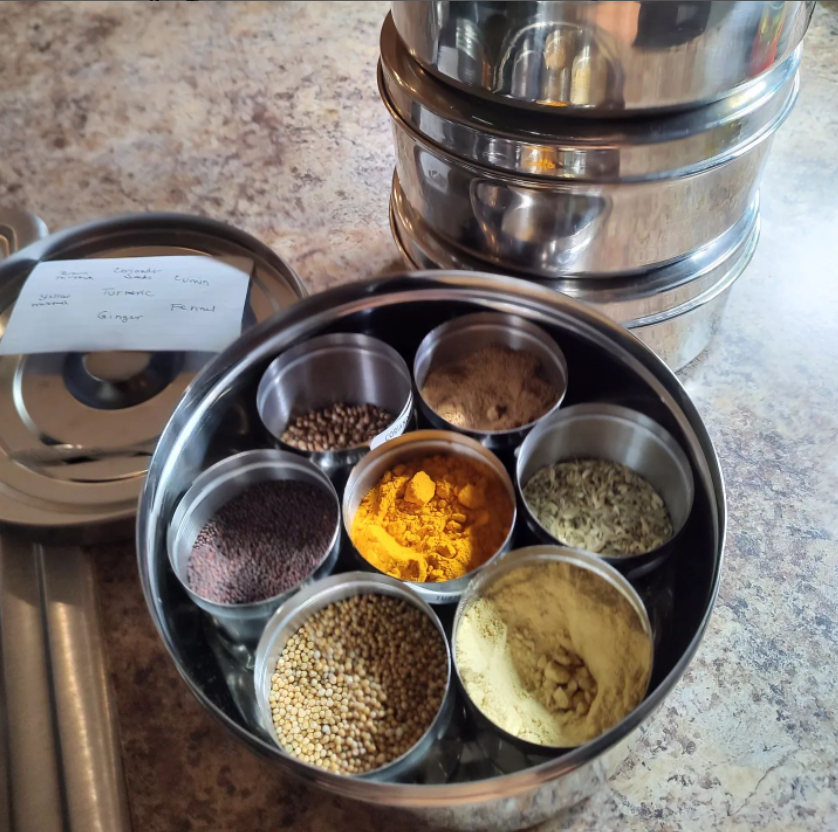
“There is no reason to build every meal as a Buddha bowl.”
Not an exact quote from Dr. Rosy during one of our digestion and nutrition classes. We had covered food combining disasters with Kate in one of our many cooking classes. And Dr. Rosy was adding more information for us to chew on and digest.
Surprisingly, no one dropped out of school when they heard no more banana and cow’s milk smoothies. Well, no one in our class #17 at Kripalu’s Foundation of Ayurveda School.
Okay, I digress as usual. Kitchari is on the menu today. And the Buddha bowl reference is because I really built this way over the top. I could not help myself. Too many organic veggies in the bin, and shelf life is limited.
Kitchari, also spelled kichari, is a staple dish in Ayurvedic cooking.
Typically a base of yellow split mung beans and basmati rice. The yellow split beans/lentils are the easiest to digest and used often in cleanses. I have used red lentils and those work fine for my gut when things are running along smoothly.
Mung beans are a great choice for digestible foods, and when hulled, the outer green covering is removed to present us with the delicate split bean, yellow split mung.
The kitchari is cooked soup-like and will include spices such as cumin, coriander, and fennel. However, spice is key in Ayurvedic cooking, and adding spices is a way to not only enhance flavor but to add healthy components to a dish.
Ghee, a clarified butter is a titanic part of the process, however, as a vegan, I use coconut oil. I do not know of any happy cows in Florida. My teachers have shared companies they vouch for that only make ghee from happy cows. I am not on board at the time.
Now onto the meal making.
Ingredients:
Water: lots of good quality water to soak, rinse, and use in cooking.
Bean: mung, best is the yellow split mung which is hulled from the green mung. Kombu if you have it to assist digestion of beans. I buy kombu from Mountain Rose Herbs in Oregon. Banyan Botanicals is my source for yellow split mung beans.
Grain: white basmati, I buy from either Banyan Botanicals or my grocery store.
Fat: coconut oil; ghee (if you insist).
Spices: seasonal spices, or cumin, coriander, fennel are great for digestion year-round.
Veggies: seasonal, local, and organic if feasible. I used asparagus, green beans, celery, sweet potato, and yellow baby squash. I was able to get everything from my Saturday market. It can be made without veggies, or with only one or two. Dr. Rosy prefers simple.
Greens: seasonal, I used kale from my Saturday market.
Supplies:
Medium to large pot with lid or Insta-Pot, potholder or towels, spoon rest, measuring cups and spoons, spatulas, serving utensils, and bowls. Fine strainer for rinsing rice and mung. Small sauté pan if toasting spices now. Towels of various sizes, small bowl for fat, and spices for tempering. Love, patience, and gratitude. Cutting board, chef’s knife, cat removal. Serving bowls, napkins, utensils—typically only a spoon.
Clean the surfaces after removing cat; wash your hands after cat removal. Wash them again—sans jewelry and nail polish. Naked hands and wrists.
Stuff to keep in mind:
Spices are important in Ayurveda cooking and using either those that work anytime or those best in season determines what you use. In addition, whole seeds are best and may be used as is, or toasted in a dry pan, cooled, and ground. If not grinding the seeds, they can be added to a small heated pan with ghee or oil to draw out the flavors. Take a few sniffs and your salivary glands will start juicing. Already ground spices can be used and so no need to heat, just add them to the pot when the beans and rice come to a boil.
Some seeds jump and bounce when heated. It only takes a couple minutes in a hot pan to release the fragrance and so no leaving the stove! Mustard seeds are famous for their acts of leaping.
I use Kate O’Donnell’s books to create spice mixes and I make about a two to a four-week batch that I store in tiny glass jars, properly labeled. However, I am also fond of using whatever spices I want to serve various purposes. I am hooked on fenugreek for its maple syrup smell and taste, as just one example.
So, the fastest spice-wise if making mixes is either earlier that day or a day or week before. Set aside an hour and make some spice mixes. Remember that you can use all ground spices so do not skip out on making this if you do not keep seeds in the home.
Diversity though is important to a healthy gut. Diversity in spices, veggies, fruits, grains. Beans, legumes, nuts, seeds, greens. Just remember the rule to aim for seasonal, local, organic, or best for you to bring balance when you feel out of whack.
Check Kate O’Donnell’s books, I highly recommend all three.
Regarding the fat, since I use organic virgin coconut oil, I put about a tablespoon or less in a small pretty bowl a friend bought me in Chinatown, New York City, around 39 years ago. A set of four with matching spoons for miso soup. I give away stuff all the time; these are still with me.
To heat my oil, I put water in a Pyrex bowl and nuke it for 1:44 minutes and then place the bowl of coconut oil in it and add the spices I plan to use near the end of cooking. My spices to go in at the beginning are either from a premixed, by me jar, or I spoon them in from one of my four tiffins which hold 31 different spices.
Tiffins are round metal boxes with small individual open tins to hold various spices. There is a lid over the entire large one.
I am now hooked on spices and addicted. I am planning a wedding for my first tiffin and me. It will be both flavorful, and colorful. Sweet, sour, salty, pungent, bitter, and astringent. Invitations will be sent by email and posted on social media.

Another consideration is the soaking of the beans. I measure out 1/4 cup of the yellow split mung the evening before and place in a former vegan mayo jar now labeled as yellow split mung soaking. I add a heaping teaspoon of kombu to cut any nasty digestive stuff although the hulled mung should be fine without it. In the morning I make boiling water in my stainless steel kettle for my pour-over coffee, neti pot, and dried chamomile tea for my hair. I use that to soak the mung and kombu for later that day’s cooking.
I use a fine-mesh strainer and first place the basmati rice in it, 1/3 cup for more, and use the filtered water I made in the early morning to start washing it, then add in the soaked mung kombu combo and keep rinsing. I set that over on the counter, on a small rosy red towel next to the pot.
Now, let’s get started. Mise en place everything but remember to check for possible cat removal from the counters first. Wash your naked hands, please.
1. Gently rinse all the veggies, and start chopping. Strip the greens from stems and tear or coarsely chop the greens. Keep the greens on a separate towel or cutting board over by the extra water, tempering spices if using since those are added near the end.
2. Turn on stovetop light for safety, then burner, then fan. Bring the water in the pot, without lid on, to a roaring boil. If you need faster results or are using one of those fancy Instra pots, lid on.
3. Tilt the strainer and sing or talk softly to the rinsed rice, mung, and kombu as you use a small spatula, and then your clean free hand into the boiling water. Be careful.
4. Bring it to a second boil, lower to medium heat, and add the spices that are not in the oil. Add the veggies.
Do not touch or disturb the cooking process at this time; it makes for a messy, stuck to the bottom of pot mess. Trust me, I must have been doodling in my notebook when Kate mentioned that in class.
5. Keep checking to see if more water is needed. Kitchari should be either soupy or less soupy, more like a stew. I do sometimes go for a bit closer to dense.
I use a tiny Finnish knife to stab a hard veggie such as sweet potato for doneness.
6. When the veggies seem almost ready, add in the coconut oil, tempering spices. Soft strokes to let it mix in. Lid on partly. After 5-10 minutes add the greens, in this recipe, kale. Lid on with a little opening. It should take about 1-3 minutes to wilt the kale.
7. Feel free to garnish the top with either microgreens or shredded coconut.
Now time to add this happiness to a bowl, and carry it, spoon, and napkin to a quiet, peaceful spot. Take time to give gratitude. Enjoy the look, smell, and taste. Chew slowly and savor every morsel.
As usual, no critters were harmed at any part of the process. Another tiny win for the sentient beings, and this tiny blue marble we call Momma Earth.
~
For a whole bunch of delicious recipes, scroll through my author page.








Read 36 comments and reply